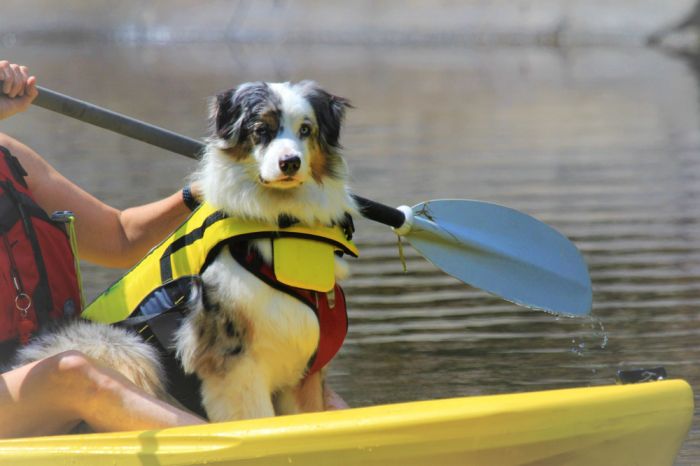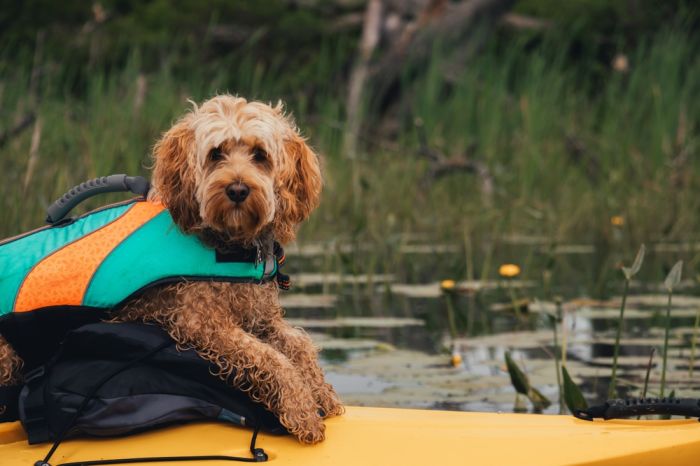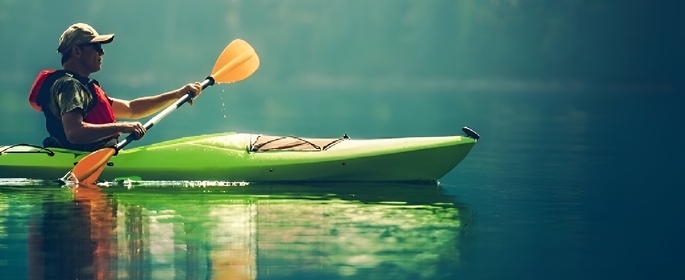Author: PaddleZone Date Posted:9 April 2024

Outdoor activities are a great way for your pet to check out some new sights and smells – all while strengthening the bond you share with them. Though a little more involved than a walk in the park, kayaking can also be an exciting pet-friendly adventure.
With the right preparation and knowhow, it is possible to bring your canine companion along and enjoy the great outdoors together. Before you rush to hit the water, we do recommend that you familiarise yourself with the various dos and don'ts, as well as invest in the right equipment.
Whether you own a Staffy, Dachshund, or a Border Collie, sharing the kayaking experience with your dog can be enjoyable and highly rewarding. Of course, it should also be safe.
As one of Australia's leading kayak specialist retailers, we have some tips and tricks to share. So, how can you go kayaking with dogs? And what are the main aspects to consider? Keep reading to find out.
Key Things to Consider
Suitability
The first step to a successful kayak canine adventure is to assess if your dog is ready and willing to take on the challenge. For example, some dogs have a natural affinity and comfort with the water, some are the opposite and others are somewhere in the middle.
Here are some things to consider:
- Is my dog comfortable around the water? If you’re unsure, start with a walk on the beach, along a river’s edge or another low-risk activity that allows them to get used to the water.
- Will my dog react positively to wearing a PFD (Personal Flotations Device or life jacket)? While some canines are comfortable wearing clothing and accessories, the opposite is true for others. This is certainly something to check before you hit the water as we recommend considering your dog’s safety as well as your own!
- Is my dog able to follow commands? From “lay down” to “sit” and many other commands, a strong connection between owner and dog will make the entire experience better for all parties.
- Can my dog swim? Of course, PFD’s are there to offset the inability to swim. However, the ability to swim is an equally important skill.
- Does my dog fit on the kayak? There has to be a balance of available space for both owner and canine. Please consider the total weight or you and your dog combined and check your kayak's capacity.Larger breeds pose a big challenge and may not be suitable for the activity as a whole. Otherwise, upgrading to a larger kayak is another option that may be worth exploring.
Safety
First things first, you must always prioritise the safety and well-being of your dog. Neglecting fundamental safety measures will only put your pet at greater risk and lead to complications for both parties.
PFD’s are more than a must have, they are non-negotiable. Like children and adults of all ages, your dog will need a well-fitted personal flotation device that keeps them protected from any water-related accidents and mishaps. Should the dog unexpectedly jump off or the kayak capsize or tilt too far to one side, the dog will stay afloat and remain close to you. It is not recommended to attach the dog leash to yourself or the kayak.
You might be thinking, "My dog's a great swimmer, why would they need a PFD?" Well, even water-loving dogs can become tired, caught in a strong current, or be startled by a sudden splash. In these situations, a well-fitted PFD is a literal lifesaver.
Some even come with additional features like grab handles, which can be a real life-saver in case your dog goes overboard, allowing you to quickly and safely lift them back onto the kayak. Others feature reflective strips that are designed to improve visibility in low light conditions – a handy addition if you enjoy paddling at sunset or dawn.
Stability
Like taking the appropriate safety measures, stability must be high on your list of priorities. A stable kayak leads to a smooth ride with minimal risks.
Here, you’ve got two types of stability to consider: initial and secondary. Initial stability refers to how the kayak feels when you first get in and start paddling on flat water. A kayak with good initial stability will feel firm and resist tipping. Secondary stability, on the other hand, is all about how the kayak handles when it's leaned to one side - something you're more likely to experience in choppy waters or after a boat has passed and its wake follows.
.jpg)
Paddling Style
Stability goes beyond the structure of the kayak itself. As the paddler, it is your responsibility to be calm when on the water and maintain a smooth style that keeps everything level. Paddling too fast, too erratically, or too infrequently can all compromise stability and put your canine at greater risk.
This is less of a concern for experienced paddlers. However, even the seasoned kayaker may take a little time to adjust and find their optimal style. It’s also important to avoid sudden jerky movements and try not to lean too far to one side.
Paddling with your dog should be a relaxing, rewarding and memorable experience. Remember, it’s not about hitting the waters at a breakneck speed, so slow down, take in the sights, and make sure that your dog has enough room, is comfortable and relaxed.
Kayak Size
Just like a poorly fitting pair of shoes can cause discomfort and even injury, a kayak that's too small or too large can result in a less-than-ideal water adventure.
Let's answer a few common questions to help you navigate the sea of size options.
1. "How big should my kayak be to fit myself and my dog?"
Well, this depends on a few factors. Firstly, the combined weight of you and your furry friend. Kayaks have a weight limit, so make sure to pick one that can comfortably handle a dynamic duo. Secondly, consider the size of your dog. Your canine companion should have enough space to move around without risking capsizing your kayak. Some dog’s will sit and enjoy the trip while others will want to be standing and be inquisitive about their surroundings.
2. "Does the size of my kayak affect the stability?"
It does! A wider kayak generally offers more stability than a narrower one, making it a safer choice for doggy passengers. But remember, it's a balancing act. A kayak that’s too large may be difficult to control and slow to paddle. Remember also bigger kayaks may be heavier and tips on managing transport and storage need to be considered too.
Now, let's weigh the pros and cons. Larger kayaks offer more space, better stability, and can handle rougher waters. However, they can be harder to manoeuvre and slower to paddle. Smaller kayaks are easier to control, faster, and generally less expensive. But they offer less space and stability, and might not be suitable for larger dogs or rough waters.
A sit on top kayak may be more suitable as deck space is often maximised whereas a sit in kayak may have limited available space. Thanks to its larger cockpit area, a sit in kayak is worth considering so it’s best to assess all the available options.
Of course, you can always stop by a kayak store and discuss kayak size with the experts. PaddleZone has a dedicated kayak shop in Melbourne, Sydney, Newcastle, and the Gold Coast. We’re passionate about all things paddling and our staff are always willing to lend a helping hand.
Environment
One of the great things about kayaking is that it gives you the chance to explore a wide variety of different waterways. From lakes and rivers to inlets and oceans, Australia is full of stunning scenery that's open and ready for exploration. While an experienced kayaker will be able to traverse many of these environments with ease, not all will be suitable for your canine.
Calm waters are the ideal starting point - think serene lakes, gentle rivers, or sheltered inlets. This will significantly reduce instability, capsizing, and general discomfort. Remember, rough waters can lead to serious distress for your dog - particularly if they’re already a little anxious to begin with.
What To Do in the Event of a Capsize
Whether you're paddling solo, in tandem, or with your dog, capsizing or tipping over is an unfortunate event that may occur. This is why it’s always best to be well-prepared and ready to react. Here is a simple step-by-step process that you can adopt;
1. Locate your dog and keep them close, talk to them in a reassuring voice.
2. Try to flip the kayak over to an upright position
3. Locate your paddle and place it back inside the kayak
4. Place your dog’s front paws on the kayak and help them back up onto the boat
5. Pull yourself back onto the kayak and check that your dog is okay
Fitting an approved PFD to your dog is a major responsibility of the owner. When a capsize occurs, this device will make your overall response significantly easier.

What if My Dog Jumps in?
While it is natural to experience some level of panic in this situation, the best response is to remain as cool, calm, and collected as possible. First, try to use a firm tone that encourages them to stay put or return to the kayak. Second, make sure to keep your paddle out of the way to avoid collision and injury.
From here, you can use the strap on the PFD to grab hold and pull them back to the edge or into the kayak itself. Because your dog may be scared, overwhelmed and cold, you will be best served to take a compassionate approach. Rather than punishing or yelling at them, try to reward them for returning. This will help to ease their anxiety and make your journey back to shore as stress-free as possible.
Stock Up on Supplies at PaddleZone
Every man and his dog can become a dynamic duo on the water with a little patience, necessary training, and the right equipment. From PFD’s and protective clothing to new paddles and tandem kayaks, it’s always better to be over-prepared than under-prepared. Stocking up on kayak accessories allows you to face any challenge and take your dog on a one-of-a-kind adventure without additional stress.
PaddleZone is Australia’s number one destination for kayaks, SUP’s, and a wide range of accessories. If you’re planning to go kayaking with a dog, we’ve got everything you need to make the experience one to remember!
Pop by our kayak shop in Sydney, Melbourne, Gold Coast or Newcastle today.


